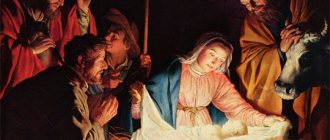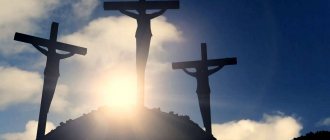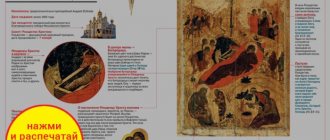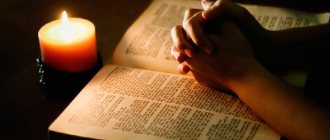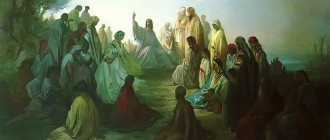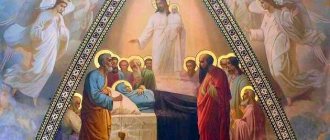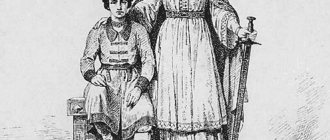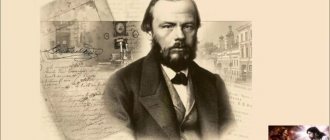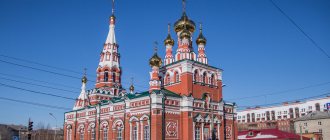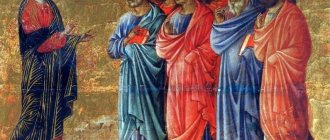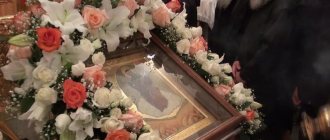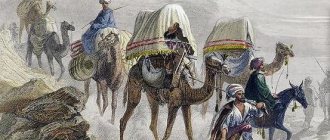After the spread of Christianity after the transformation of the Roman Empire, a considerable number of holy ascetics appeared who showed their own devotion and great faith. One of these ascetics was Saint Mary of Egypt, who is now in many churches and enjoys great respect.
Memorial Days:
- April 5 (transitionable) – 5th Week of Lent;
- April 14 – Death Day.
History of Saint Mary
Mary was born in Egypt in the fifth century AD. She stayed in her parents' house until she was twelve years old, after which she left for Alexandria, which at that time was a developed cultural and economic center. Where there is prosperity and luxury, there is almost always lust and other sins.
Therefore, Mary succumbed to licentiousness and began to indulge in bodily pleasures. For many years she allowed herself any passions and fornicated a lot. For her, it was bodily pleasure that was the main meaning and the highest bliss.
As the lives testify, Mary, for about 17 years, continually and daily indulged her own passions, in particular, she indulged in fornication. She did not collect money, she simply enjoyed bodily pleasures.
Upon reaching the age of 29, Mary went by ship to the Feast of the Exaltation of the Holy Cross, which was celebrated in Jerusalem. It was this event that became fundamental in the biography of this saint, and it was thanks to this that the woman was able to accept the true faith. At the same time, she initially went to the holiday in order to fornicate there, but she saw people going to the temple.
The Sinful Life of Young Mary
The holy elder Zosima told the world about the life and exploits of the saint. By the will of God, he met her in the depths of the desert, where he himself went to spend the Great Pentecost, far from the world, in fasting and prayer. There, on the sun-scorched land, Saint Mary of Egypt was revealed to him. The icon of the saint often depicts this meeting. She confessed to him, telling the amazing story of her life.
She was born at the end of the 5th century in Egypt. But it just so happened that in her youth Mary was far from unquestioningly observing the commandments of God. Moreover, unbridled passions and the absence of intelligent and pious mentors turned the young girl into a vessel of sin. She was only twelve years old when, having left her parents' home in Alexandria, she found herself left to her own devices in a world full of vice and temptations. And the harmful consequences were not long in coming.
Very soon Maria indulged in unbridled debauchery. The goal of her life was to seduce and involve as many men as possible into destructive sin. By her own admission, she never took money from them. On the contrary, Maria earned her living by honest work. Debauchery was not her source of income - it was the meaning of her life. This went on for 17 years.
Transfiguration of Saint Mary
Maria joined the others, but for some reason could not enter the Church of the Holy Sepulchre. At first it seemed as if the crowd was in the way and it was difficult to squeeze through a significant number of other people, but then the situation became obvious. Just as it is difficult for those possessed by demons to enter the temple, it was impossible for Mary to be there; something from above held the harlot back.
The woman felt the full weight of her accumulated sins and prayed before the Mother of God, whose icon was located in the narthex in front of the temple itself. Only after this was she able to enter the temple itself and bow. Having left, Mary again turned to the icon in the vestibule and heard instructions to go beyond the Jordan.
This is how a harlot dies and a saint is born. For the first 17 years (according to the number of years spent in fornication), the saint endured severe torment and hardship, and struggled with passions. After this, for 30 years the saint continued her asceticism in the desert, showing various miracles of faith: she soared above the earth when she prayed; walked on the water of the Jordan; could subdue the wild beasts of the desert, for example, the lion was affectionate with her and even dug a hole for the saint, kissing her feet before this when Mary rested.
Life in the desert
And only after this the Lord allowed the great sinner to the shrine. Having venerated the Life-Giving Cross, Mary heard from the icon of the Mother of God the command to go into the desert beyond the Jordan . There, the woman spent forty years completely alone. She endured hunger, heat, thirst, cold at night and fear of wild animals. But Mary suffered the greatest temptation from demons. They painted in her imagination pictures of her former dissolute life, reminiscent of sinful songs and the taste of wine. The ascetic fervently repented and mourned her dissolute life.
When Mary was attacked by the desire to return to her previous sins, she buried herself in the sand and stood there for a long time. Her clothes had decayed with age. At first she ate bread, which she took in Jerusalem, and when it ran out, she ate thorns and sparse vegetation of the desert. Only the Lord knows how she did not die of hunger and thirst.
First meeting with Zosima
Some time later, Hieromonk Zosima from the Jordan Monastery went to the desert as usual during Lent. And suddenly he saw a certain creature. Thinking that this was an ascetic, Zosima rushed to catch up with him to take the blessing. But Maria hid behind a bush, shouting to him that she was a woman. She asked him to throw her his clothes. Zosima threw her a cloak, she wrapped herself in it and went out to him. The elder asked her to tell about herself. Maria did not want to tell him about her dissolute life for a long time, but finally she agreed and told him in detail about her sins. But the ascetic did not want to talk about her exploits in the desert. She only said that she was illiterate and could not read or write. And, despite this, Mary quoted the Holy Scriptures and the Holy Fathers. Apparently, an Angel in the desert read Divine books to her.
While they were praying, Maria rose into the air and stood there to the horror of Zosima. Then she predicted to the elder that during the next Great Lent he would not be able to leave the monastery due to illness. But on Maundy Thursday a year later, she asked him to return to this place to commune her with the Holy Mysteries. He complied with her request. When he arrived, he wondered how the saint would cross the Jordan River. But then he saw her walking along the river like dry land.
Second meeting with Zosima
The elder gave her communion, Maria asked him to return to the same place exactly one year later. And again she crossed the river as if on dry land. When Zosima returned there a year later, he saw the saint already dead. Nearby in the sand there was an inscription referring to him with a request to interred her body. He was surprised to remember that she could not write. Then he saw a large lion approaching him. At first he was afraid, but realized that the lion did not notice him.
Leo approached the saint's body and began to dig a grave for her. The elder buried her body in the sand and returned to the monastery, where he told the story of the saint. This legend was passed down from mouth to mouth, and in the seventh century it was written down by the monk Sophronius.
How does the saint help?
Every Christian ascetic leads people to true faith and helps them strengthen their own path to the Almighty.
However, each saint has, let's say, his own more specialized department. It is in this specialized area that you should ask for help. Thus, if you ask yourself what the icon of Mary of Egypt helps with, the answer becomes obvious. The most effective prayer is to this saint when one should reject lustful passion. Such help is very relevant these days, when depravity literally permeates society.
If we touch on the meaning of the icon of Mary of Egypt, then the saint can also provide support when you simply need to get rid of various passions and turn your attention to the eternal and sublime
Mary's feat inspires other people, and her icon is revered by both monks and lay people. As believers say, this saint can help pacify passions and give inspiration for strong faith.
The infinity of God's mercy
The mercy of the Lord is all-encompassing. There is no sin that could surpass His love for people. It is not for nothing that the Lord is called the Good Shepherd. No lost sheep will be left to perish.
Heavenly Father will do everything to turn her onto the true path. All that matters is the desire to cleanse yourself and deep repentance. Christianity provides many such examples. The most striking among them are Mary Magdalene, the Prudent Thief and, of course, Mary of Egypt, whose icon, prayer, and life showed many the path from the darkness of sin to the light of righteousness.
Icon options
In order to pray, a simple icon of the Venerable Mary of Egypt can be used, where she is depicted on a plain background with a halo.
In addition, three versions of the saint’s scripture are common:
- image in the life - the saint herself stands in the center, and along the perimeter the main stages of the life are depicted in stamps (indicated earlier, miracles in the desert, communion and repose);
- an icon of St. Mary, where she remains in prayer to Christ or the Mother of God;
- communion and meeting with Elder Zosima.
Elder Zosima was practically the only person with whom the saint saw. It was he who, at the beginning of her ascetic life, gave her part of his clothing to cover her nakedness, and it was he who brought the sacrament when Mary became a saint. In order to take communion, the ascetic crossed the Jordan as if it were land.
"Go beyond the Jordan..."
After realizing her own sinfulness, the woman burst into tears. Then I saw an icon of the Mother of God in front of me. Stained with vices, she prayed before the Most Pure Virgin. The harlot repented of her sins so much and promised to change so much that the Mother of God and Christ accepted her prayer.
The woman entered the church, bowed in repentance to the Cross of the Lord, near which she heard the answer to the most important question: “What next?” The voice said:
Go beyond the Jordan, there you will find blissful peace
Mary of Egypt did just that, taking communion before crossing to the other side of the Jordan.
She had no spare clothes or food supplies. 47 years in solitude. Only three loaves of bread for food. The clothes have long since worn out. The desert climate cannot be called mild: sweltering summer heat, cold winter nights. But prayer and deep repentance nourished her, kept her warm in the cold.
Prayers before the icon of St. Mary of Egypt
Troparion, tone 8
In you, mother, it is known that you were saved, even in the image,/ having accepted the cross, you followed Christ/ and, in your deeds, you taught to despise the flesh, which passes away,/ to lay close to the souls things that are immortal.// Likewise, the venerable Angela will rejoice Marie, your spirit.
Translation: In you, O mother, that which is in us in the image [of God] was surely saved: for, having accepted the cross, you followed Christ and by your deeds taught to despise the flesh, for it will pass away, but to be zealous for the soul, the immortal thing. That is why your spirit rejoices with the angels, Reverend Mary.
Kontakion, tone 3
First filled with all sorts of fornications,/ The bride of Christ has now appeared in repentance,/ imitating the angelic life,/ destroying the demon of the cross with weapons.// For the sake of the Kingdom, the bride has appeared Thou art, most glorious Mary.
Translation: Having at first been consumed by all kinds of fornication, you have now become the bride of Christ through repentance, imitating the angelic life and destroying demons with the weapon of the cross. That is why you became the bride of the Kingdom of Heaven, glorious Mary.
Kontakion, tone 4
Having escaped the darkness of sin,/ having illuminated your heart with the light of repentance, O glorious one,/ you came to Christ,/ to whom the All-Immaculate and Holy Mother/ You brought a merciful prayer book./ From there and you have found forgiveness of your sins, // and you will always rejoice with the Angels.
Translation: Having escaped the darkness of sin, having illuminated your heart with the light of repentance, worthy of glory, you came to Christ, and you made His All-Immaculate and Holy Mother your merciful Prayer Book. That’s why you received forgiveness of your sins and always rejoice with the Angels.
Greatness
We bless you, like Mother Mary, and honor your holy memory, teacher of monks and interlocutor of Angels.
First prayer
Oh, great saint of Christ, Reverend Mary! In Heaven you stand before the Throne of God, but on earth you are with us in the spirit of love, having boldness in the Lord, pray to save His servants, who flow to you with love. Ask us from the Most Merciful Master and Lord of faith for immaculate observance of our cities and villages, for deliverance from famine and destruction, for those who mourn - consolation, for those who are sick - healing, for those who have fallen - rise knowledge, strengthening for those who go astray, prosperity and blessing for good deeds, orphans and widows - intercession and eternal rest for those who have departed from this life, but on the day of the terrible Judgment, at the right hand of the land, we will all hear the blessed voice of the Judge of the world: come, blessed of My Father, us follow the kingdom prepared for you from the foundation of the world, and you will abide there forever. Amen.
Second prayer
Holy and great saint of Christ Mary, who surprised the Angels with her unparalleled feat! We pray to you, blessed one, standing now at the Throne of the All-Holy Trinity, begging the Lord, having found great boldness before Him, may He grant us, like you, to repent of our numerous sins, and forgive us from us, and may we be punished here because of His love for mankind, not will destroy us in the future. Pray, Holy Mary, to your Most Holy Helper, who strengthened you in your struggle as a laborer, that she may strengthen us, the All-Holy One, with Her all-powerful help, on this earthly thorny path, and I You, having kissed the All-Honorable Cross of Christ with faith and love, have received grace You destroyed His All-Powerful One in the fight against the devil, the world and the flesh and valor, by all the machinations of Satan, so may we also be granted the help of the Life-giving Tree of the Cross of the Lord to destroy all the barriers of sin to attainment of the heavenly Kingdom, and having been rewarded with eternal life, together with you I will sing the praises of the Most Holy Trinity in We are one being, Father, Son, and Holy Spirit forever and ever. Amen.
Prayer three
Oh, great saint of Christ, like Mother Mary! Hear the unworthy prayer of us sinners (names), deliver us, O holy mother, from the passions that war on our souls, from all sorrow and adversity, from sudden death and from all evil, at once radiance of the soul and body of marriage, holy saint , every evil thought and crafty demons, for may our souls receive in peace into the bright place of Christ, our Lord our God, for from Him is the cleansing of sins, and He is the salvation of our souls, to Him All glory, honor and worship are due to the Father and the Holy Spirit , forever and ever. Amen.
( 2 ratings, average: 5.00 out of 5)
Righteous Death, Elder Zosima and the Wild Lion
The hermit asked him the next year, on the same day, to come to the same place. Elder Zosima fulfilled her wish. But instead of walking on the waves and rising up in prayer, he saw the incorruptible body of Mary of Egypt with her hands folded crosswise. Above her head was an address to him:
Father Zosima! Bury here the body of the humble Mary, who died on April 1
This was exactly the day when the monk gave communion to the righteous woman.
Her body was “guarded” by a lion. According to legend, a wild beast licked the saint’s feet. And then, as if understanding the thoughts of Elder Zosima and the covenant of the deceased, with his claws he helped the monk dig a burial hole.
April 14, 2021 marks 1492 years since the righteous death of Mary of Egypt.
But for almost 15 centuries, her feat of repentance has been honored by the Holy Church. The fifth week of Lent is named in her honor. After all, it is precisely at this hour of grace for repentance and change that many believers are strengthened by the example of the righteous life of the saint.
